LATEST NEWS


It is a sign of how far right the Republican Party has moved that New York Times columnist Ross Douthat describes Rep. Paul Ryan as a “moderate.”
In his column on Sunday, “Four Factions, No Favorite,” Douthat looked at the likely candidates for the 2016 Republican presidential nomination. Drawing on an article by Henry Olsen in the conservative journal National Interest, Douthat divides the GOP core voters into four groups: centrist (“think John McCain’s 2000 supporters or Jon Huntsman’s rather smaller 2012 support”), moderately conservative (“think the typical Mitt Romney or Bob Dole voter”), socially conservative (“think Mike Huckabee or Rick Santorum backers”) and very conservative but more secular (“think Gingrich voters last time or Steve Forbes voters much further back”).
Reviewing the stellar cast of likely GOP wannabes for 2016 (Chris Christie, Ted Cruz, Scott Walker, Jeb Bush,


The conventional wisdom of capitalism is encapsulated in the phrase “trickle down.” This means the money that some very rich people have accumulated gets invested in ways that create jobs, and the money dribbles down the social pyramid, first to administrators, then white collar managers and bureaucrats, then to the assembly line or shop floor workers, then to the janitors. General Motors used to be the quintessential capitalist corporation. “What was good for General Motors,” it was believed during the Eisenhower years, “was good for the country.”
Then in the 1980s, an economist from USC sold Ronald Reagan on a re-constructed version of this model. He called it “supply side economics.” This notion claims that the more goods are available for people to buy, the more money will concentrate in the upper reaches of the rich, and somehow, this is good for the country. The Walton family heirs to the Walmart fortune are a good example of this business model.
» Read more about: Trickle Down Profits Don’t Raise Any Boats »


If you’ve ever had to remodel or make major repairs on your home, then you know hiring the right contractor and constant oversight is key to a job well done. After all, if anything goes wrong, it is your time, money, and home at risk.
The Newark Star-Ledger covered a new study by Rutgers University that illustrates exactly this point with government contracts. According to Overlooking Oversight: A Lack of Oversight in the Garden State is Placing New Jersey Residents and Assets at Risk, contracts in the Garden State are often executed without adequate oversight or with poor contract language lacking high performance standards and accountability.
This is a big deal because unlike home renovation contractors that affect our porches, government contractors affect services that profoundly shape people’s lives—lives such as the victims of Hurricane Sandy.
» Read more about: Jersey Study: Subcontracting for Trouble »
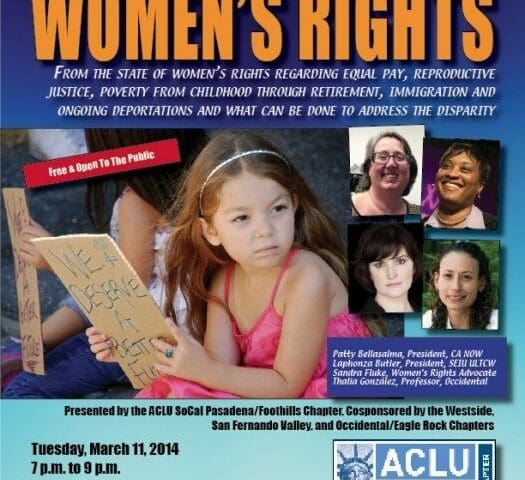

Tuesday’s bimonthly SoCal ACLU discussion forum will address the topic of women’s rights. Organized by the ACLU’s Pasadena/Foothills chapter, the event promises to be a much larger event than usual, prompting the chapter’s Sharon Kyle to announce its move to a bigger venue. Discussion topics will focus on women’s economic, political, social and legal rights, said Kyle, who publishes LA Progressive. Four guest speakers include the California president of the National Organization for Women, Patty Bellasalma; Service Employees International Union United Long Term Care Workers president Laphonza Butler; attorney and activist Sandra Fluke (who so angered Rush Limbaugh two years back), and Occidental College professor Thalia González.
Kyle, who says that she and other black women haven’t always felt connected to the women’s movement, thinks this particular topic is ready for revisiting. For Kyle, the intersection of race and gender is central to the Women’s Rights Forum.
» Read more about: Laphonza Butler, Sandra Fluke Speak at Women’s Forum »


You may have heard that American Airlines is ending its policy of offering bereavement fares for passengers seeking last-minute tickets to attend family funerals. The announcement passed as do most news stories about the downsizing of American generosity – with a nostalgic whimper and corporate waiver. When CNN asked American Airlines the reason for the change, the company hid behind US Airways, the no-frills step-sister with which it had recently merged.
“In order to have a single, consistent program for American and US Airways,” read a canned statement, “we will adopt the US Airways policy and now offer customers the option to purchase changeable and refundable fares.”
In other words: US Airways made us do it! CNN didn’t ask American why it didn’t do the opposite and make US Airways adopt American Airline’s bereavement policy. Perhaps after more than a decade of beating contract concessions and givebacks from its unions,


Minnesota is cold. When I visited the state in early February, surprisingly, the subzero temperatures weren’t the only reason for this impression. It was actually the sight of 122 acres of mangled metal above the Mississippi River that chilled me to the bone.
In St. Paul, a former Ford factory, which operated for more than 80 years and employed thousands of workers manufacturing cars, is being demolished. Seeing firsthand the historic Twin Cities Assembly Plant’s demise and the loss of so many quality, unionized American manufacturing jobs made me feel a keen sense of grief.
Ironically, I had come to Minnesota to encourage the creation of U.S. manufacturing jobs, by advocating that the Twin Cities regional planning agency, called the Metropolitan Council, leverage its purchases of buses and trains. I represented the Jobs to Move America coalition, which unites more than 30 community,
» Read more about: A Manufacturing Pulse Beat in the Heartland »
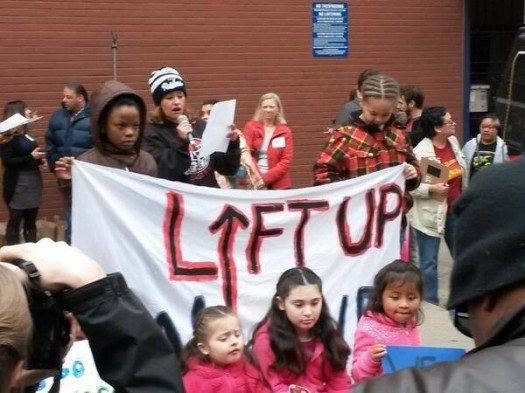

A man wearing the uniform and cap of a fast-food worker, his apron tucked into a pant pocket, approached a clerk at the Alameda County Social Service Agency. As he handed over documents for his public assistance benefits claim, the man explained how it had felt to be waiting in the lobby for the past several hours:
“I was the first here and the last to leave.”
“You should get a pay check!” the clerk responded.
The reality is that this man does “get a paycheck” from his minimum wage job, but finds himself unable to meet his basic needs. This is a common scene at my office in Oakland and public assistance offices across the country.
This month’s National Association of Social Workers’ theme is “All People Matter,” chosen to remind us of our profession’s commitment to improving social conditions for all.
» Read more about: ‘All People Matter’ — It’s Time to Raise the Minimum Wage »
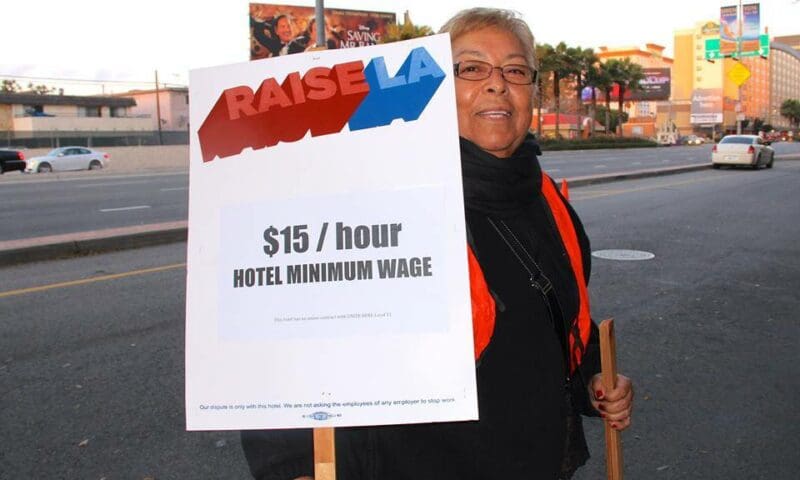
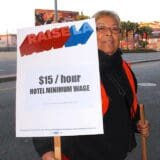
In an economy where constant, unpredictable change is a given, wages are one of the few things that have remained reliably stagnant. However, a growing national movement to address this increasingly visible issue is taking shape. Locally, Raise LA, a coalition of labor and community groups organized by the Los Angeles Alliance for a New Economy (LAANE), is part of a push to bring wages up to speed by advocating for better jobs in L.A.’s massive hospitality industry. According to a LAANE Raise LA report, “Residents, workers and businesses from communities across Los Angeles are united in the Raise LA Coalition in an effort to ensure that the city’s largest and most profitable hotels support the communities in which they operate.”
So why is Raise LA specifically focusing on hotels? One in 10 jobs in Los Angeles County is in the leisure and hospitality industry,
» Read more about: Raise LA Campaign Targets Hospitality Industry’s Low Wages »


The most difficult conversations for most activists happen with family. Particularly with parents or aunts and uncles, and cousins who disagree with a politically progressive perspective. My parents and I stopped talking about world events long before they died. I think that is a fairly normal behavior choice — just stop talking. When I visit with cousins who live in red states or the red parts of blue states, I almost always try to avoid any discussion that could lead to conflict. And I think they do too.
On the other hand, such difficult discussions are sometimes hard to avoid. Late last fall I received a screed forwarded by a cousin who lives in one of those red places on the map about an issue I thought had long gone the way of most such topical conflicts: the President’s birth certificate. I knew this was still a hot issue in some quarters during the President’s reelection,


Are job protections for teachers to blame for educational underachievement among low-income students of color in California? That’s the provocative question ostensibly at the heart of Vergara vs. California, which seeks to invalidate the tenure, due process and seniority rights of hundreds of thousands of educators.
Astute observers of the nation’s escalating education wars, however, may be asking another question: When did it become permissible to use the welfare of children as a fig leaf for an all-out legal attack on teachers?
Or, as historian and teacher John Thompson wrote recently in Scholastic, “Are corporate reformers unabashedly using the courts as a battleground for battering employees’ rights, as opposed to helping children?”
Sadly, the answer to Thompson’s question appears to be an unequivocal yes. For while the outcome of Vergara will have far-reaching national implications, it is hardly unique in its attempt to scapegoat teachers for sub-par educational performance.
» Read more about: Vergara v. California’s Corporate Heart »
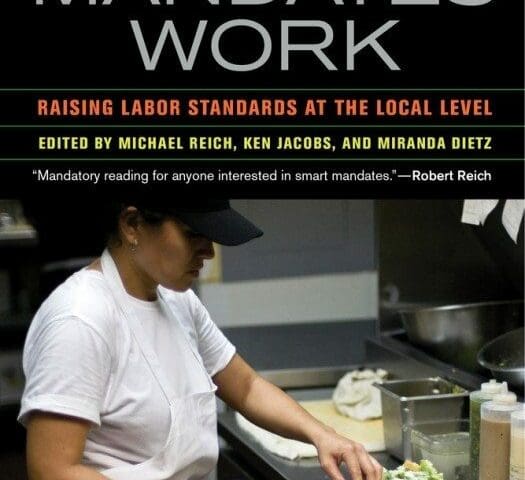
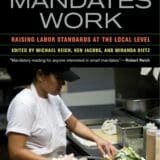
Forget, for the moment, downer news stories coming out of Midwestern statehouses, Southern auto plants and sundry federal courts. A new book edited and co-written by three Bay Area researchers optimistically chronicles what can be accomplished when progressive politicians and a determined electorate, backed by an energetic union movement, tackle income inequality, health care, labor peace and other challenges. When Mandates Work: Raising Labor Standards at the Local Level, edited by Michael Reich, Ken Jacobs and Miranda Dietz, parses a dozen years of legislation passed by San Francisco voters or their board of supervisors. Thanks to 10 ordinances enacted between 1996 and 2008 —
In an interview with Capital &
» Read more about: How San Francisco Created a New Social Compact: An Interview With Ken Jacobs »


After the President’s State of the Union address, federal policy circles are squarely focused on how to speed and grow America’s economic recovery. President Obama was right when he said America needs “a set of concrete, practical proposals to speed up growth, strengthen the middle class and build new ladders of opportunity.”
America’s public transportation infrastructure provides one excellent opportunity to build a more equitable, prosperous economy. Here are five policy prescriptions that can help create good jobs and growth in the transportation sector:
1. Make a globally competitive investment in infrastructure. Increase federal funding to address America’s infrastructure deficits identified by the American Society of Civil Engineers and detailed in the BlueGreen Alliance’s Repair America report, especially in the transportation sector. Investments in transportation can put Americans back to work while rebuilding our crumbling roads and bridges, and improving the efficiency of our rail and transit systems.
» Read more about: Five Policy Prescriptions for Transportation Job Creation and Growth »


Last year Walmart commissioned a study on itself, and now its findings can be revealed: Walmart is the greatest thing since penicillin. More specifically, the study sees the chain-store titan’s widening footprint on America’s retail landscape as a gift for the communities lucky enough to have a Supercenter land on them.
The research, conducted by the Hatamiya Group, a Davis-based firm owned by Lon Hatamiya, is predicated on a comparative analysis of taxable retail sales and retail business permits, and reaches two conclusions: “On average,” California communities with Walmart Supercenters in them have fared better economically than those without them.
Of course, while it may be difficult to name a community that doesn’t have a Walmart in it, California is a very large state and has places where even Walmart won’t tread – economic no-go zones that have been especially hard-hit by the recent recession and slow recovery.
» Read more about: Walmart’s New Research: A Flattering Self-Portrait »
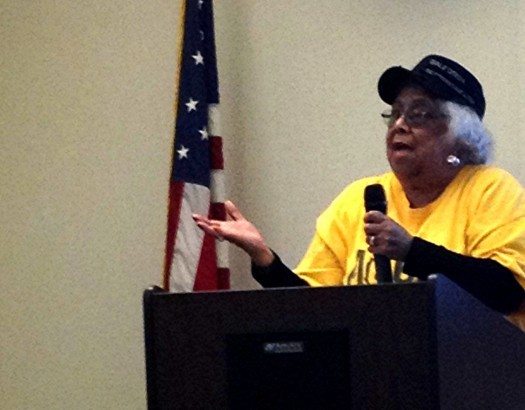

The Alliance of Californians for Community Empowerment (ACCE) held a town hall meeting February 6 to discuss its new Fix Unemployment Now campaign, which aims to make unemployment insurance more accessible in light of recent problems with California’s Employment Development Department (EDD). The meeting, which took place at Service Employees International Union (SEIU) Local 721’s headquarters in Los Angeles, drew members of ACCE and SEIU, EDD employees and members of the community. (Full Disclosure: The author of this article has previously volunteered for ACCE.)
Fix Unemployment Now primarily addresses EDD’s failure to provide unemployment checks on time and to answer claimants’ questions and concerns. According to ACCE, these problems are related to EDD’s decision to outsource a computer upgrade to Deloitte Consulting, a company that has been fired by other public contractors in the past. According to the Los Angeles Times, EDD is so unresponsive that it answers only a fraction of the phone calls it receives.
» Read more about: Campaign Targets California’s EDD Failure »


We Americans don’t like to think of our country as corrupt – or at least as corrupt as Japan, whose yakuza crime syndicates have taken over much of the legitimate business sector, including providing materials for the Fukushima nuclear reactor and scooping up homeless people to work as cleanup crews there. Of course we’re not like India, where things only get done with a bribe. And hopefully we’re not as bad as Russia, where this year’s Winter Games have been called “the most corrupt in Olympic history.”
Still, corruption sure feels pervasive here. Last year the people who run the banks, insurance companies and stock brokerages contributed $10 million to the legislators who sit on the House Financial Services Committee. That body makes the rules for the finance industry. Known as a “juice committee” because membership is so lucrative, House leaders added 61 more positions to the panel, because so many Congressmen wanted to sit on it.


Last week’s testimony in the Vergara v. California trial raised many an eyebrow when Los Angeles Unified School District (LAUSD) Superintendent John E. Deasy testified on behalf of plaintiffs in a lawsuit whose defendants had originally included LAUSD.
Despite its supporters’ protests to the contrary, Vergara is widely seen as a frontal attack against statutory guarantees of due process and seniority rights for state teachers. The suit is the brainchild of Students Matter, a Bay Area nonprofit created by wealthy Silicon Valley entrepreneur David Welch and partly financed by L.A. billionaire Eli Broad.
Under friendly direct examination by plaintiff attorney Marcellus McRae, the superintendent offered testimony that supported the suit’s contentions that the way in which teachers are fired, laid off and granted tenure has an adverse impact on the overall quality of the teacher workforce and illegally discriminates against low-income and minority students.
» Read more about: Deasy v. Deasy: The Two Faces of L.A.’s School Superintendent »
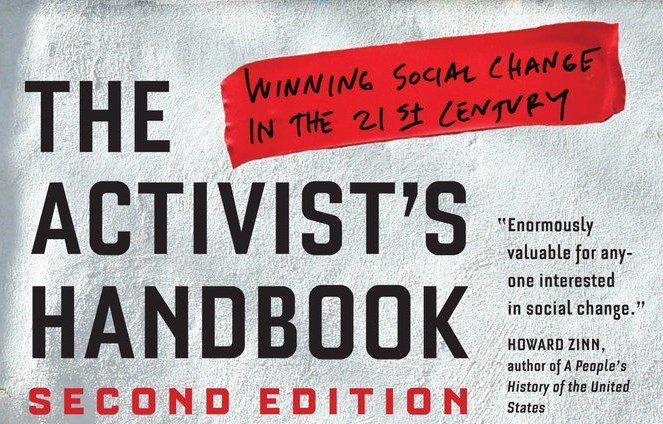
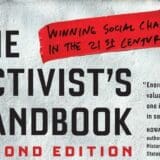
Randy Shaw does not fit the rabble-rouser profile. An upper-middle-class native of West Los Angeles, he came to San Francisco in 1979 to enroll in the city’s prestigious Hastings Law School, whose downtown campus is part of the University of California, Berkeley. There, however, he discovered that his school had for years been expanding by swallowing up residential hotels catering to low-income residents in the adjacent Tenderloin district.
“It used to be,” Shaw remembers, “that if you wanted to evict someone in the Tenderloin you’d throw them down a flight of stairs. Then it became more civilized: You’d just threaten to throw them down a flight of stairs.” In 1980 he co-founded the Tenderloin Housing Clinic as a legal aid resource for neighborhood residents. But it soon grew into an aggressive grassroots organization battling developers who wanted to replace much of the Tenderloin with luxury tourist hotels.
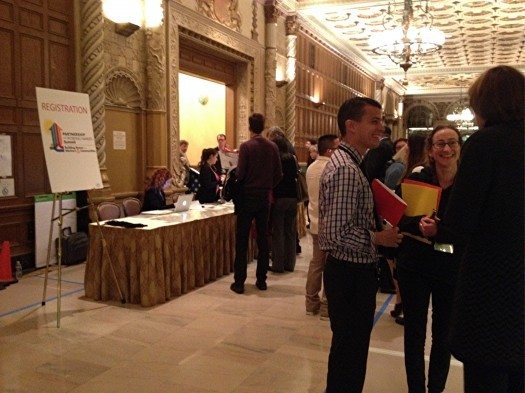

The Partnership for Working Families Summit kicked off Tuesday in Los Angeles as activists from around the country convened at the Biltmore Hotel for three days of workshops and talks focused on creating good jobs, sustainable industries and strong unions.
The Partnership includes such groups as the Los Angeles Alliance for a New Economy (LAANE), Puget Sound Sage and the Alliance for a Greater New York (ALIGN). While attendees came from a range of organizations and campaigns, the idea that cities can be platforms for change provided a common thread. As Leslie Moody, the Partnership’s outgoing executive director, put it in her opening remarks, “Cities matter.”
Moody pointed to the new set of progressive mayors taking office across the U.S., but added that elected leaders do not act alone. She cited the way communities have pushed new civic officials to follow through with constructive policies.
“We’re not going to wait for federal change,” Moody said,


Every year for Black History Month, the TV networks and premium movie channels roll out the same programming: Malcolm X, Mississippi Burning, The Color Purple…. It’s not that these films aren’t great; they are. It’s just that every year for as long as they have been around, they’re all that come on during February. I can quote The Color Purple line for line. The history of black folks is larger and more diverse than the civil rights movement and slavery. Let’s give some other films a shot, shall we?
Let the Fire Burn
In the spring of 1985 a bomb was dropped on a row house in Philadelphia. A fire spread quickly and burned down 61 houses, eventually killing 11 people, including five children, and injuring numerous others. The fire and police departments stood by and did nothing to stop the blaze.


Every January, our state celebrates the work and legacy of Dr. Martin Luther King Jr., a hero who sacrificed his life in the fight to end discrimination and poverty in America. In this respect, it seems appropriate that January is also the month when our Governor releases his budget proposal. The State Budget is more than numbers; it reflects our collective priorities and funds what is most important. Sadly, this budget proposal fails to honor Dr. King and his fight for justice. Within the Governor’s proposal are further cuts to critical social service programs. There is no clearer or more tragic example of this disinvestment than our state’s willingness to cut access to state-sponsored child care for low income families. In the name of justice and equality, we ask the Governor to fully fund child care to ensure universal access to all and quality work conditions for providers.
Currently we have more than 300,000 children languishing on waiting lists,